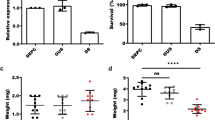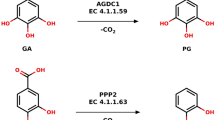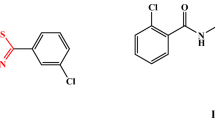Abstract
DURING the course of an investigation into the hardening of the cuticle of the desert locust Schistocerca gregaria, 4-methyl-catechol, a substance not previously recorded from insect cuticles, was identified chromatographically in abundant amounts from fully hardened cuticles after acid hydrolysis as well as after alkaline hydrolysis under reducing conditions. This substance, although absent from the soft cuticles newly exposed on moulting, is readily detected after they have been artificially tanned with B-(3 : 4-dihydroxyphenyl)acetic acid, indicating decarboxylation of the tanning agent. If B-(3 : 4-dihydroxyphenyl)propionic acid is used in place of the acetic derivative to tan the cuticles a compound with similar properties is recovered from the cuticles. This latter compound, which is also present in aqueous extracts of naturally tanned cuticles, has an R F value, in benzene/acetic acid/water, slightly higher than that of 4-methyl-catechol. It can only be presumed to be 4-ethyl-catechol similarly formed by decarboxylation. B-(3 : 4-dihydroxyphenyl)acetic acid and 4-methyl-catechol have also been detected after tanning cuticles with B-(3 : 4-dihydroxyphenyl)-propionic acid, and the formation of these compounds seems a clear indication that degradation of ortho-diphenolic compounds in an insect cuticle1 to compounds having shorter side-chains may be accompanied by decarboxylation. Hackman and Todd2 have already demonstrated the decarboxylation in vitro of 3 : 4-dihydroxybenzoic acid in the presence of a plant phenolase.
This is a preview of subscription content, access via your institution
Access options
Subscribe to this journal
Receive 51 print issues and online access
$199.00 per year
only $3.90 per issue
Buy this article
- Purchase on SpringerLink
- Instant access to full article PDF
Prices may be subject to local taxes which are calculated during checkout
Similar content being viewed by others
References
Richards, A. G., “The Integument of Arthropods” (University of Minnesota Press, 1951).
Hackman, R. H., and Todd, A. R., Biochem. J., 55, 631 (1953).
Hackman, R. H., Biochem. J., 54, 371 (1953).
Malek, S. R. A., Proc. Roy. Soc., B, 149, 557 (1958).
Dennell, R., Proc. Roy. Soc., B, 148, 176 (1958).
Kennaugh, J. H., J. Insect Physiol., 2, 97 (1958).
Author information
Authors and Affiliations
Rights and permissions
About this article
Cite this article
MALEK, S. Homocatechol in an Insect Cuticle. Nature 185, 56 (1960). https://doi.org/10.1038/185056b0
Issue date:
DOI: https://doi.org/10.1038/185056b0



